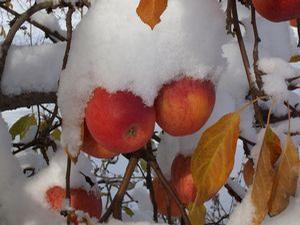Winterizing Concerns

Winter can be a harsh season for trees. However, there are many ways you can protect your investment.
Cold Temperatures and Your Precious Trees
Do you worry about the cold temperatures and the effect it could have on your young trees? If you live in an area that is having an unusually cold or snowy winter, you should really be concerned only with how severely low the actual winter temperatures have been. Deep snow can actually be a benefit to trees, unless the snow is so deep, heavy and sticky that it is breaking down trees. During the winter snow can act as an insulating barrier which helps prevent the ground from freezing too deeply or from freezing at all. Often, if you have had continuous snow cover, you can dig through it and find unfrozen ground. It also helps to recharge the water table when it melts off during the spring. The big threat is from unseasonably cold temperatures and/or cold “snaps”. Don’t worry about the “wind chill temperature”. It is the actual air temperature that the plants and trees feel. Since they are not heat generating bodies, they tend to cool and warm in step with the air temperature.
However, you do need to be a bit concerned when the bright winter sun reflects off the snow and onto the trunks of your trees. It may appear on the snow line or shine directly onto the trunk from its lower angle in the winter sky. This warming up can lead to winter damage when the trunks heat up during the day and then refreeze at night, particularly on the southwest side of the tree. A better way to protect from this “southwest damage” is to paint the trunks with white latex paint (do not use oil base). Paint from the ground level all the way up into the first branches or the “crotch” of the tree. This is particularly helpful on tender stone fruits, like peaches, nectarines, apricots, plums and cherries. It does not hurt to paint apple or pear trees either. The white paint will reflect much of the winter sun. You can thin the paint down with water a little bit to make it easier to apply. Some folks use a glove or sponge for a quicker way to apply the paint to the trunk.
You should also be concerned that your fruit trees may have been damaged by cold temperatures if you had several hours or days of temperatures below what is typical for your Hardiness Zone. If your temperatures were close to the low limit, then you may have damage ranging from loss of fruit buds to wood damage. In severe cases damage can outright kill the tree. What you may see in the late spring or early summer on tree damage is a sudden collapse of what appears to be a healthily starting tree. The center, heart wood of the tree is still able to transport nutrients up the tree to the leaves, but the outside bark parts of the tree are damaged so severely that they can’t transport anything down. A severely damaged tree can die quickly, but in some cases the tree will recover. Often winter damaged trees take several years to “pass on”, it will often just depend on the severity of the actual damage.